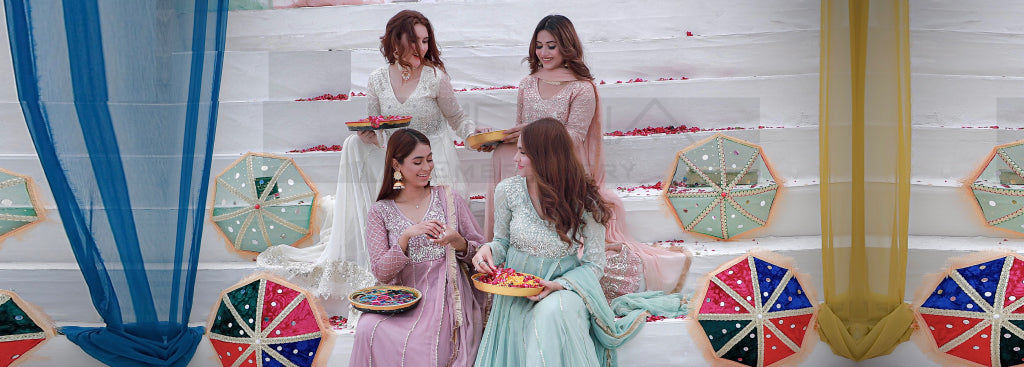Pakistan's rich cultural past and fashion industry have always been entwined. Creating a nation known for its vivid textiles, fine craftsmanship, and eclectic aesthetics. Clothing labels have been essential in defining the country's sartorial identity, and Pakistan's fashion industry has undergone a remarkable change throughout time. This article takes you on a fascinating tour of Pakistani fashion, examining the development of local clothing firms. Also, their influence on the national and international fashion scene. And the distinctive combination of traditional and modern designs that characterize Pakistan's fashion sector.
The Early Days
The advent of tiny, regional clothing producers that catered to specific markets can be credited with Pakistan's first clothing brands in the middle of the 20th century. The main focus of the fashion industry at this time was traditional clothes, with an emphasis on locally manufactured fabrics and handcrafted ornamentation.
Due to the increased demand for fitting clothing, particularly for weddings and other occasions, local tailoring shops and boutique stores have grown in popularity. These small-scale enterprises laid the foundation for the growth of clothing brands in Pakistan, setting the stage for a remarkable journey of transformation and innovation.
The Rise of Couturiers
In the 1980s and 1990s, a new wave of Pakistani fashion took shape with the emergence of couturiers who revolutionized the industry. These visionary designers brought high fashion to the forefront, showcasing their creativity and craftsmanship on prestigious platforms both locally and internationally.
Pioneering fashion houses like "House of Amir Adnan," "Bunto Kazmi," and "Rizwan Beyg" showcased traditional ensembles with a contemporary twist, blending cultural elements with modern design sensibilities. They not only earned recognition within the country but also put Pakistan on the global fashion map.
Bringing Traditional Crafts to the Forefront
One of the defining features of clothing brands in Pakistan is their dedication to preserving and promoting traditional crafts. Brands like "Khaadi", "Limelight" and "ChenOne" led the way in incorporating handwoven fabrics, block prints, and intricate embroidery into their collections. By infusing traditional crafts into modern silhouettes, they catered to a diverse audience seeking authentic, culturally-rich attire.
This revival of traditional crafts not only created opportunities for local artisans but also presented Pakistani fashion as a unique blend of heritage and contemporary aesthetics, captivating fashion enthusiasts both locally and abroad.
Ready-to-Wear Revolution
Pakistan's garment industry underwent a major change in the latter half of the 1990s and into the 2000s with the arrival of ready-to-wear apparel businesses. Brands like "Gul Ahmed," "Al-Karam," and "Maria B" introduced affordable, stylish, and accessible ready-to-wear collections, making fashion more approachable for a broader demographic.
Ready-to-wear brands tapped into the growing urban middle-class market, offering contemporary designs that were both trendy and affordable. This democratization of fashion empowered women from all walks of life to express their style and individuality through clothing.
The Bridal Couture Sensation
The early 2000s witnessed a surge in the popularity of Pakistani bridal couture, with designers like "HSY" and "Sana Safinaz" leading the way. Bridal wear became a cornerstone of the fashion industry, with extravagant fashion shows and bridal weeks becoming the norm.
The fusion of traditional craftsmanship, opulent fabrics, and modern design concepts redefined Pakistani bridal wear. These bridal couture brands showcased their creations not only in Pakistan but also at international fashion weeks, gaining accolades from fashion connoisseurs worldwide.
Fashion Weeks and Retail Expos
The 2010s saw a significant rise in the frequency and scale of fashion weeks and retail expos in Pakistan. Events like "PFDC Fashion Week" and "Fashion Pakistan Week" became platforms for emerging and established designers to showcase their collections.
These fashion weeks not only celebrated the diversity and creativity of Pakistani fashio. But also provided a platform for clothing brands in Pakistan to connect with buyers, media, and fashion enthusiasts. The exposure gained from such events helped brands expand their reach and gain national and international recognition.
Global Expansion and E-Commerce
With the advent of e-commerce, Pakistani clothing brands found new avenues for growth and global expansion. Many brands set up online stores, making their collections accessible to a global audience. E-commerce platforms have eliminated the need for traditional retail middlemen by enabling firms to engage directly with customers.
Pakistani clothing firms have successfully entered the diaspora market, catering to the needs of Pakistanis living abroad while also winning over thos. Who are interested in global fashion and seek out distinctive, culturally-informed designs.
The Fusion of Eastern and Western Fashion
The evolution of clothing brands in Pakistan also led to the fusion of Eastern and Western fashion. Many brands began experimenting with blending traditional aesthetics with contemporary Western silhouettes, prints, and fabrics.
This fusion not only appealed to the modern Pakistani woma. But also garnered attention from international audiences seeking distinctive and culturally-rich fashion. Pakistani clothing brands stood out for their ability to cater to diverse tastes, offering a seamless blend of heritage and modernity.
Social Impact and Sustainability
Pakistani apparel companies have recently placed a greater emphasis on sustainability and social impact. Brands like "Sapphire" and "Generation" have been at the forefront of promoting moral and environmentally friendly business practices in the fashion sector.
These companies have aided in the empowerment of regional communities by fostering fair trade principles and fostering close relationships with local craftspeople. Additionally, they have made tremendous progress towards eco-friendly fashion by implementing eco-friendly production techniques and fabrics.
Conclusion
The journey of clothing brands in Pakistan is a testament to the rich cultural heritage, creativity, and resilience of the nation's fashion industry. The development of Pakistani fashion has been an enthralling story of invention and aesthetic expression. From the early days of neighbourhood tailor shops to the international acclaim of Pakistani couture.
Due to their unique fusion of traditional craftsmanship and contemporary trends. Pakistani fashion designers and manufacturers continue to have an impact on the fashion world. Pakistani fashion has the potential to make a significant, long-lasting impact on the fashion industr. Because of its dedication to cultural preservation, sustainability, and diversity.



